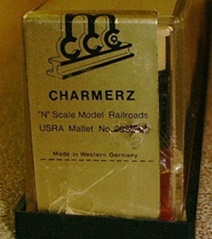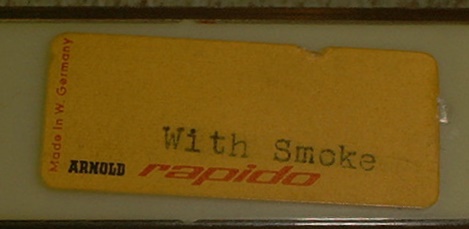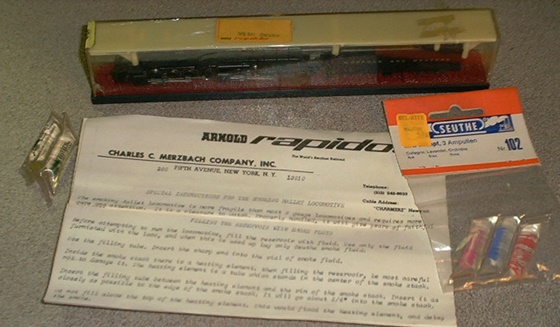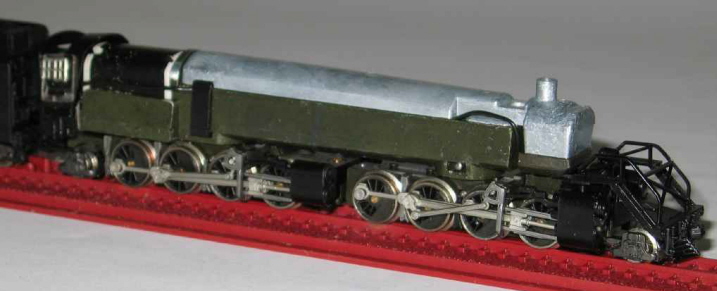

Introduced 1969 (by MRC/Rowa), reissued briefly in the mid-1970s (Charmerz/Rowa, Bemo), re-reissued in 1977 (by Con-Cor/Rivarossi), and transmorgrified in 1983 (Con-Cor/Rivarossi 2-8-8-0)
As noted above, this legendary model has had a wild and wooly history as far as its manufacture is concerned. It all starts in 1969 when MRC decided to take their big plunge into N scale. And as part of that kick-off, they contracted Rowa (a German company) to create the tooling for this model (along with the tooling for an equally legendary 2-8-4 Berkshire).
As it turns out, MRC's commitment to N scale was pathetically short-lived and they wound up dropping their entire line after just a couple of years (1971). At this point, one Charles Merzbach (an early pioneer in the business of importing N scale models into America) enters the picture. Merzbach was the original US importer for the entire Arnold-Rapido line of N scale models- an exclusive relationship that lasted up until 1969, at which point Arnold decided to cut a new import deal with Revell (a deal that basically removed Merzbach from the equation). Merzbach, being understandibly miffed about being cut out of a nice import business (and one that he'd nurtured himself), decided to start work on his own line of N scale models (to be called Charmerz).


At some point circa 1974-75, Merzbach contracted Rowa to produce a slightly modified mallet model. This release was different from the original MRC/Rowa (and later Con-Cor/Rivarossi) versions in a couple of different ways. First off, the drawbar connection between the locomotive and the tender was completely different (more on that in a moment). More importantly, it allowed for the installation of a Suethe smoke unit (more on that in a moment too). And as it turns out, this short-lived project was the only Charmerz item to ever actually make it to market.
Once Merzbach vanished from the scene (I'm told he wound up committing suicide, yikes), Con-Cor stepped in as the importer for the Rowa models (both the original MRC version as well as the newer Charmerz smoker version). Rowa subsequently went out of business in 1975, at which point the original MRC/Rowa tooling was purchased by Con-Cor and set up for production at Rivarossi. Oddly enough, Bemo (another German company) somehow wound up with the tooling for the Charmerz smoker version. The Con-Cor/Rivarossi version ceased production in 2006 when Rivarossi went bankrupt. As for the Bemo models, my guess is that these were sold exclusively in Europe. And since they are quite rare, I assume this was a fairly short-lived offering. According to Jim Conway (Con-Cor president) that tooling vanished somewhere along the line and has never resurfaced.

As far as I know, all of the post-MRC Rowa production (as imported by Con-Cor) retained the original MRC packaging (with the locomotive sitting upright in a clear plastic box, and with the MRC stickers simply being replaced by "Rowa" stickers). The Charmerz mallets used the same packaging (with the above-pictured Charmerz and Arnold Rapido stickers). The later Con-Cor/Rivarossi imports came in cardboard Con-Cor boxes. The Bemo mallets came in Bemo packaging.

OK, now let's take a look at the actual models...
| MRC/Rowa - | Con-Cor/Rivarossi - |
The chassis is all-metal on all versions (as are the basic "guts" therein). FWIW, I'm told that the composition of the Zamac chassis metal in the Rivarossi version is superior to the mixture used by Rowa and Bemo. However, given the vagueries of Zamac, crumbling and cracking frames are a potential problem for all of these models (although at this point in history, if you have one where the frame has not started to deteriorate, it probably never will).
Pickup on all versions is the same - right-rail pickup is provided by six of the right side drivers and left-rail pickup is provided by four of the left side tender wheels (with the center wheels on each truck being electrically neutral). The pilot and trailing trucks on the locomotive are electrically neutral as well. Each set of four drivers has one pair that is equipped with traction tires. All drivers are geared. The pilot coupler is a non-operational knuckle, whereas the tender coupler is a truck-mounted Rapido. A non-directional headlight is mounted to the front of the chassis. The wheel flanges are reasonably sized, so no problems on Code-55 track.
Now, how that left-rail current gets from the tender to the motor varies (as does the drawbar connection) -
- MRC/Rowa - The drawbar has a hole that mounts on a metal pin on the tender. Left-rail current is transferred via a flexible, insulated wire
running from the tender to the motor
- Charmerz, Bemo - The drawbar is screwed into place permanantly on both the tender and locomotive sides. Current transfer is the same as
on the initial Rowa version (IE, flexible wire)
- First (1977) Con-Cor/Rivarossi version - same as MRC/Rowa
- 2-8-8-0 Mallet (with Vandy tender) - The drawbar connection is the same as the first MRC/Rowa version. Current is transferred from
the tender to the motor via a stiff wire on the drawbar (IE, no separate flexible wire)
- Final Con-Cor/Rivarossi version - Same as the first Rivarossi version, excepting that the current-conducting wire has a metal
pin/plug connector (allowing the tender to be completely disconnected from the locomotive)
The first MRC/Rowa imports (along with mid-70s smoker version) had German can motors. Once Rivarossi took over production, they replaced the German can motor with their own in-house can. Circa 1989, Rivarossi introduced an "improved" can motor. And in the mid-1990's, the can was given the boot entirely (replaced by an open-frame, 3-pole, skew-wound motor).
The Rowa and Bemo versions had plastic running gear and plastic gears in the gear towers of each truck. The Rivarossi versions replaced the plastic running gear with metal gear. Additionally, they used brass gears in the gear towers instead of plastic ones. The final runs of the Rivarossi-made Mallets (mid-to-late 1990s) had blackened wheels. The tender and shells managed to remain the same throughout.
All versions are impressive looking and running models - in fact, the ones I have are easily some of the best steamers I own (after the Gold Standard - Kato's Mike). Smooth, relatively quiet (more on that in a moment) and with solid performance at all speeds. No hesitation, no jerkiness and no wobbling. However, I will say that the later Rivarossi versions (with the brass gears) do tend to run noticeably louder than the older Rowa and Bemo versions (which run almost sans sound). No, not horribly noisy, but they do have a definite growl to them.
I'm told that the reason for the change to brass gears was that the old plastic gears were prone to cracking. However, I've owned several of the old (now very old) MRC models and those plastic gears have held up very well, thank you very much. However, if your's haven't faired as well, NWSL does offer replacement gears (or at least they did as of this 2012 writing). The catalog number is 1054-6.
As mentioned above, the mid-70s Charmerz and Bemo models were available with a smoke generator. This had the benefit of adding more weight (and thus increasing pulling power). On the downside, the noxious smoke goo did tend to eat the surrounding metal and plastic. Additionally, the locomotive headlight had to be jettisoned (with the headlight wiring being routed to the smoke unit instead).

Circa 1983, Rivarossi took the 2-8-8-2 shell and mechanism, removed the trailing truck, added a Vandy tender (the same tender that came with the CC/Riv "Heavy Mikado") and released it as an EL-5 2-8-8-0 Mallet. The EL-5 model follows the same post-1983 history/evolution as the 2-8-8-2 (with the aforementioned differences in its tender-to-locomotive electrical/drawbar connections).
Note that the tenders on these models are not particularly friendly when it comes to decoder installation. The top, bottom, and sides are all a single casting and the ends are firmly glued in place. Consequently, opening one up without damaging it is virtually impossible.
Grade: A (for all of 'em)
Reviewed: 5/70 Model Railroader ("The N scale ready-to-run model comes painted and lettered. It closely follows prototype dimensions and proportions... The model has well-detailed cast plastic superstructures on both engine and tender. The truck frames, valve gear, side and main rods, and tender floor are cast plastic. The engine frames, frame covers, and boiler ballast are zinc alloy castings. The drivers have plastic centers with metal rims. The truck wheels are metal, insulated on one side. All wheels are slightly under scale dimension... The flanges are .026" deep. The check gauge is .322". All 16 drivers are powered. A motor in the cab and firebox drives a horizontal shaft in the boiler which drives each engine unit through a brass-worm-and-plastic-gear and spur-gear drive arrangement. All wheels on each unit are geared, eliminating any possibility of side-rod bind. The engines are pivoted between the second and third drivers in an unprototypic but mechanically sound arrangement. This allows the model to negotiate short-radius model curves and divides the weight between the front and rear engine to provide excellent traction. In many articulated models the rear engine does the work, with the front engine doing little or nothing in the way of pulling. With two friction treads on each engine unit, this model has an excellent pulling capacity. Like the MRC 2-8-4, this model is very smooth-running. The minimum speed is about half the average N scale locomotive minimum... Our test sample had good starting characteristics. Control was good through all speed ranges. The maximum speed is far above that of the prototype, so most control is effected below 8 volts. The model will negotiate very sharp curves due to the gimbal-type mounting, but a minimum radius of 11" is recommended. On sharper curves the model tends to have excessive overhang. On curves of 15" and up the swiveling of the rear engine is not noticeable. The model should handle about 40 freight cars... Stall amperage is close to the estimated motor rating, so extra ballast is not recommended; there isn't room for it, anyway... An unusual feature is the headlight, which is neatly hidden in an extension of the front engine frame. This extends up into the smokebox. The small lamp bulb points down and a clear plastic rod transmit light to the pilot-mounted headlight. This is a very fine model both in looks and operation... Price: $46.95")
(Thanks for the picture of the "smoker", Mike)